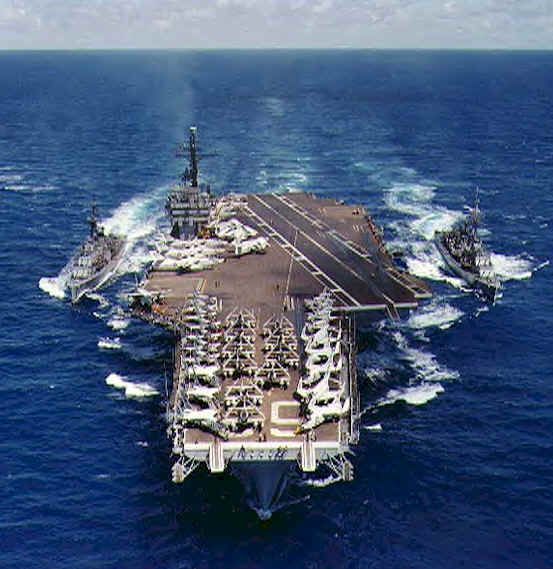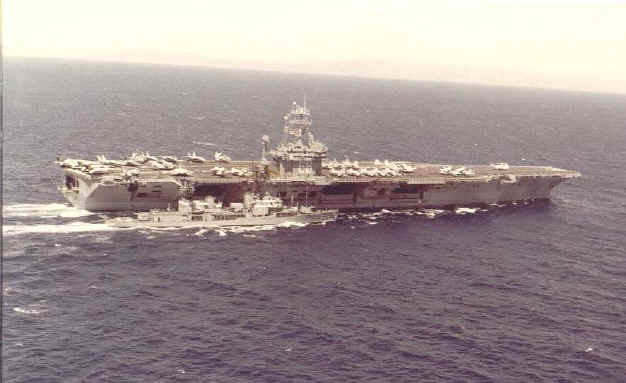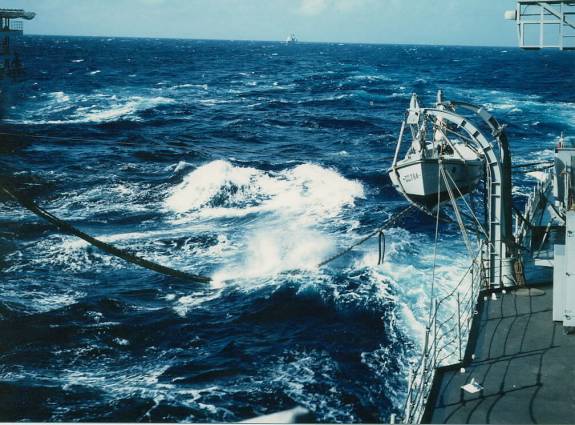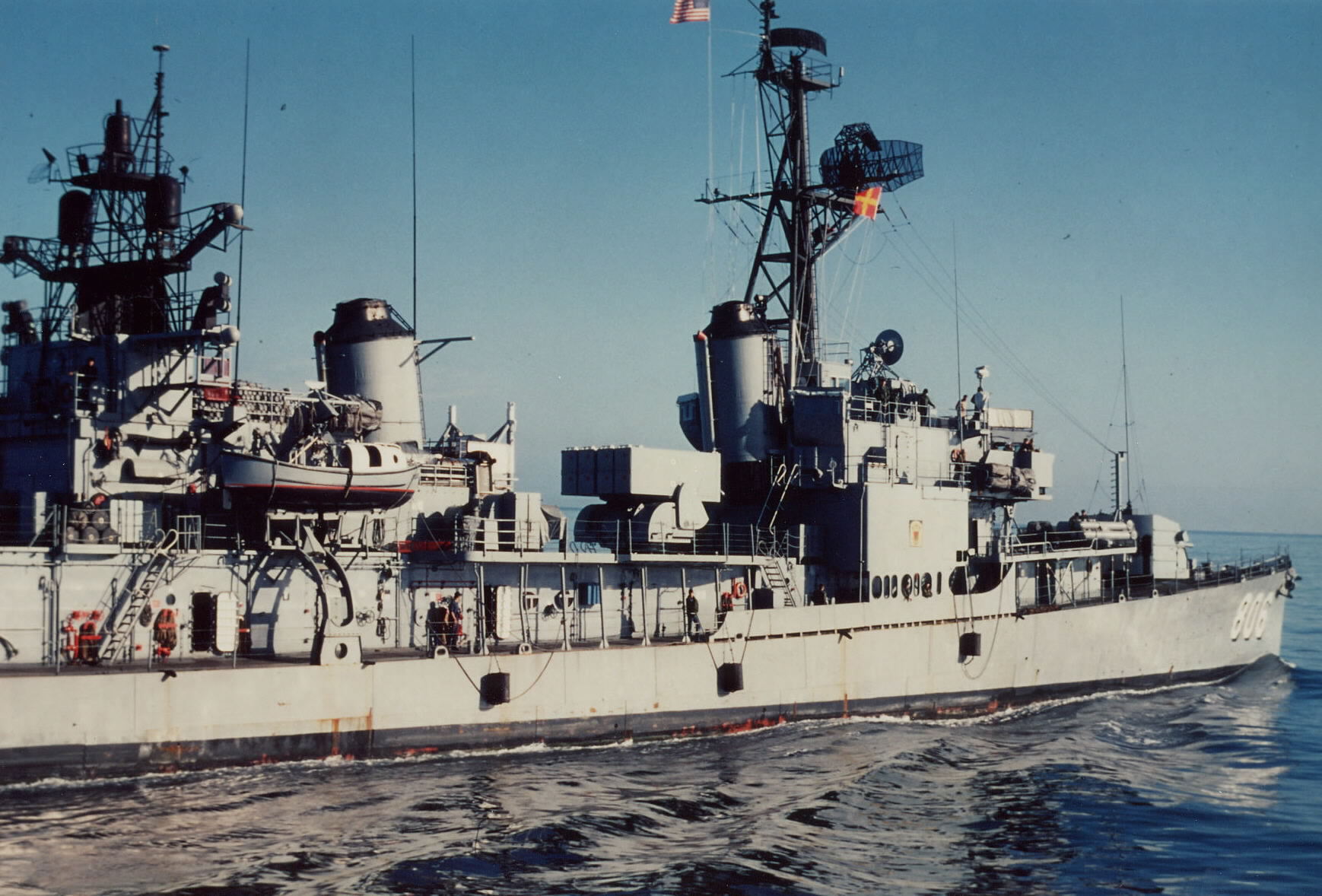Ever Wonder HOW you Fuel up a FRAM DESTROYER, while under
way? This article should answer some questions.

DOG ZEBRA by
Dave Hood, GMT2
USS McKean (DD 784)
 There’s great duty and there’s lousy duty.
There’s gravy assignments and there are *&%$ details.
Being assigned to the U.S.S. McKEAN DD784 in the late 70’s was a gravy
assignment. Our home port was in
Seattle at a leased municipal pier that we shared with two minesweepers, the
CONQUEST and the ESTEEM, and another FRAM, the USS HIGBEE DD 806. The nearest naval stations were either the Naval Shipyard
across Puget Sound at Bremerton or the Naval Support Activity at Sandpoint at
the other end of Seattle. There
were no signs saying, “Sailors and dogs keep off the grass.” The locals
actually liked us. As far as my
shipmates were concerned, the worst *&%$-sucking duty in the world would be
aboard a showboat cruiser like the U.S.S. LONG BEACH in a place like San Diego,
or, even worse, anywhere on the east
coast.
There’s great duty and there’s lousy duty.
There’s gravy assignments and there are *&%$ details.
Being assigned to the U.S.S. McKEAN DD784 in the late 70’s was a gravy
assignment. Our home port was in
Seattle at a leased municipal pier that we shared with two minesweepers, the
CONQUEST and the ESTEEM, and another FRAM, the USS HIGBEE DD 806. The nearest naval stations were either the Naval Shipyard
across Puget Sound at Bremerton or the Naval Support Activity at Sandpoint at
the other end of Seattle. There
were no signs saying, “Sailors and dogs keep off the grass.” The locals
actually liked us. As far as my
shipmates were concerned, the worst *&%$-sucking duty in the world would be
aboard a showboat cruiser like the U.S.S. LONG BEACH in a place like San Diego,
or, even worse, anywhere on the east
coast.
For an ASROC Gunners’ Mate, a gravy underway watch
station was either sonar, after-steering or the ASROC control station.
A lousy watch-station was anything the Bos’n Mates had to man, such as
forward lookout, aft lookout and any bridge watch.
During an underway replenishment (UNREP) a horrible
assignment was line handler. A
gravy assignment was ship-to-ship phone talker.
Line handlers were on the main deck, some six feet above the waterline,
were always wet and cold, no matter how calm the seas were.
The ship-to-ship phone talker stood on the flight deck on the O-1 level,
got to see everything, stayed dry and got the opportunity to shoot the breeze
with his counterpart on the other ship.
If you’re a destroyer sailor, you’re familiar
with an UNREP. If you’re not a
Tin Can Sailor, let me explain the process.
Ships at sea burn a lot of fuel. (I heard that the typical fuel
consumption was 100 gallons per HOUR.) Destroyers
may get their best fuel economy at, say 15 knots.
At that speed, a FRAM has a range of 5,800 miles.
But remember - this is a destroyer story, written by a destroyer sailor
to be read by other destroyer sailors who have all served aboard destroyers.
And what is it that destroyers like to do best? We like to go real fast.
And the only thing that consumes more fuel then a destroyer with all of
its boilers lit off is the space shuttle on take-off.
About every three days we would need
to top off. The “Heavy”
could be a fleet oiler such as the USNS CAYUGA, a replenishment ship such as the USS MOUNT SHASTA or
even an aircraft carrier. The
“escort” would pull up alongside the “heavy” at about 15 to 20 knots and
try to maintain a constant distance of about 120 feet apart.
A shot-line would be fired from one ship to the other.
Attached to the projectile was a spool of common “550” parachute
cord, orange in color. The
“heavy” would attach a heavier line to their end of the shot-line .
The escorts line-handles would haul the shot-line back aboard.
Then the heavier line would be pulled aboard.
To the heavier line, the “heavy” would attach an even heavier line.
Spliced onto that line would also be the sound-powered phone line. The
phone-talker (me) would plug in and be able to speak directly to his counterpart
on the other ship. That heavier
line would be pulled aboard by the line-handlers.
Finally, the “heavy” would attach a steel cable to the end of the
line and that would be pulled aboard the “escort’’.
The cable would be attached to a fitting on the “escorts” fueling
station. (On a FRAM, we
traditionally used the fueling station on the flight deck at the rear of the
ship-located forward of the rear 5” gun mount.
There was another fueling station forward, up on the torpedo deck-just
forward of the bridge. For some unknown reason, we rarely used this station at
sea.) The fuel probe would slide
down the cable and mate up with the fuel station.
The ships would then steam, side by side, for as long as it took to
transfer fuel. It usually took
about an hour. It always seemed to
take longer if the weather was crappy.
such as the USNS CAYUGA, a replenishment ship such as the USS MOUNT SHASTA or
even an aircraft carrier. The
“escort” would pull up alongside the “heavy” at about 15 to 20 knots and
try to maintain a constant distance of about 120 feet apart.
A shot-line would be fired from one ship to the other.
Attached to the projectile was a spool of common “550” parachute
cord, orange in color. The
“heavy” would attach a heavier line to their end of the shot-line .
The escorts line-handles would haul the shot-line back aboard.
Then the heavier line would be pulled aboard.
To the heavier line, the “heavy” would attach an even heavier line.
Spliced onto that line would also be the sound-powered phone line. The
phone-talker (me) would plug in and be able to speak directly to his counterpart
on the other ship. That heavier
line would be pulled aboard by the line-handlers.
Finally, the “heavy” would attach a steel cable to the end of the
line and that would be pulled aboard the “escort’’.
The cable would be attached to a fitting on the “escorts” fueling
station. (On a FRAM, we
traditionally used the fueling station on the flight deck at the rear of the
ship-located forward of the rear 5” gun mount.
There was another fueling station forward, up on the torpedo deck-just
forward of the bridge. For some unknown reason, we rarely used this station at
sea.) The fuel probe would slide
down the cable and mate up with the fuel station.
The ships would then steam, side by side, for as long as it took to
transfer fuel. It usually took
about an hour. It always seemed to
take longer if the weather was crappy.
One night off the California coast we pulled up alongside
the aircraft carrier USS KITTY HAWK CV 62. As soon as our communications were
established I told my counterpart that we were requesting 40,000 gallons of DFM
and that the maximum pressure that we could receive was 100 psi.
“Wait one,” came the response.
“Kitty Hawk, McKean. The minimum pressure that we can send is 120psi.”
“Wait one.” It was my turn to use the standard Navy response phrase.
I told that to the engineering representative and he told me that it
shouldn’t be a problem.
“Kitty hawk, McKean. We are standing by to receive 40,000 gallons of DFM
at 120 psi MINIMUM.”
“Roger that McKean. 40,000 at 120 minimum.”
 Did you notice that I started the preceding paragraph by
saying, “One night?” That’s
right. Night. As in dark. Real dark. Middle
of the freakin’ ocean dark. One
thing about US Navy warships at sea at night: they don’t like to show lights.
Pure darkness is the rule. The
only topside illumination comes from special floodlights that have red lenses.
They project just enough light for you to see what your doing but not
much more then that. Did you notice that I started the preceding paragraph by
saying, “One night?” That’s
right. Night. As in dark. Real dark. Middle
of the freakin’ ocean dark. One
thing about US Navy warships at sea at night: they don’t like to show lights.
Pure darkness is the rule. The
only topside illumination comes from special floodlights that have red lenses.
They project just enough light for you to see what your doing but not
much more then that.
So there we were. It
was the middle of the night in the middle of the ocean.
Two ships tethered together steaming at 22 knots.
My ship weighed 2,250 tons, the other weighed 86,000 tons.
We were 390’ long and 40’ wide.
The KITTY HAWK was 1,069’ long and 252’ wide. Our main deck was 6’
above the waterline. The KITTY
HAWK’s flight deck was 85’ above the waterline. They had the gas and we
needed it. Everything was equitable.
After awhile the Engineering rep told me to tell the Kitty Hawk that our
tanks were nearly full and for them to prepare to cease pumping.
“McKean, Kitty Hawk. Standby to cease pumping.”
“Kitty Hawk aye. Standing by.”
Five minutes later and I was instructed to pass on the word to cease
pumping. I was instructed that we
would then want a “Back Suction and then a Blow Down.”
(The ship-to-ship fueling hose is corrugated rubber and about 5” in
diameter and several hundred
feet long. It must hold hundreds of gallons of fuel.
A “Back Suction” is supposed to suck the fuel out of the hose and
back in to the tanker’s fuel tanks. A
“Blow down” is the forcing of compressed air through the hose to blow any
vapors into the receiving ship’s fuel tanks.)
”McKean, Kitty Hawk. Standby for your back suction and blow down.”
“McKean aye. Standing by.”
There are no instruments nor are there any gauges on the
flight deck. Nothing to indicate
what is happening. But I could tell
something wasn’t right. Instead
of the sucking, wheezing sound of fuel being sucked OUT of the fuel hose, I
heard something different, something unfamiliar.
Before I could figure out what was different I heard the new sound of
popping metal and expanding gasses. I
could now no longer see the fuel probe. It
was swallowed up in a fog. The fog
then expanded forward towards me. That didn’t make any sense.
We were moving forward at 22 knots and yet the fog was coming up from
behind and catching up with us. And
then the fog swallowed up me. It was wet and it smelled. It clung to me and
penetrated my clothing. It was
fuel! I realized what happened. Instead
of giving us a “back suction” and sucking out all of the remaining fuel in
the hose, the KITTY HAWK started off with a “blow down.” The remaining fuel
was trying to be forced into our already full tanks. The HP air driving the fuel was atomizing it and the fueling
station’s seals blew under the pressure.
The entire aft end of the ship was enveloped in an expanding cloud of
fuel!
I could feel the fuel penetrating my clothing and
clinging to my skin. “CEASE
PUMPING! CEASE PUMPING! CEASE PUMPING! McKean, Kitty Hawk! Stop your
goddamn pumping!” I again looked at this cloud of fuel that had swallowed
us up. I began to envision someone
coming out on deck: someone ignoring the fact that the smoking lamp was off. I
looked at the fuel fog that swallowed up the red lens flood lights. I wondered about the condition of the waterproof gaskets.
I just knew that at any moment the vapors would ignite. Would I be aware
of the flash? Would it instantly sear me? Would
I have time to see it ignite and then envelope me?
I took of my helmet and let it fall to the deck.
I reached behind my neck and undid the sound-powered phone set. I was
about to discard that too and then run. But
run where? I’m on a ship. In the
middle of the ocean. There was
nowhere to run to. It wouldn’t
where I ran to. If the ship
exploded I would be just as dead on the bow as I would on the flight deck.
And if I was to die I might as well die on my station doing my duty.
I put the phones and helmet back on.
By then the KITTY HAWK must have realized their error for they were now
giving us our back suction. By the
time that was done the wind blowing over the ship had dissipated the fuel fog.
The KITTY HAWK retracted the fuel probe and I disconnected the phone set
and tossed their phone line over the side. I don’t recall if I sealed the jack
in a plastic bag or not. We
released the pelican hook and let the cable go.
We maneuvered to starboard and got some distance between us and the KITTY
HAWK and then returned to our lifeguard station in her wake.
All of us on the aft station were hosed off with a 1 ½” fire hose and
then excused from water hours so we could take a hot fresh water shower.
Two days later we again refueled from the KITTY HAWK.

 

|
